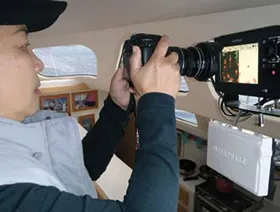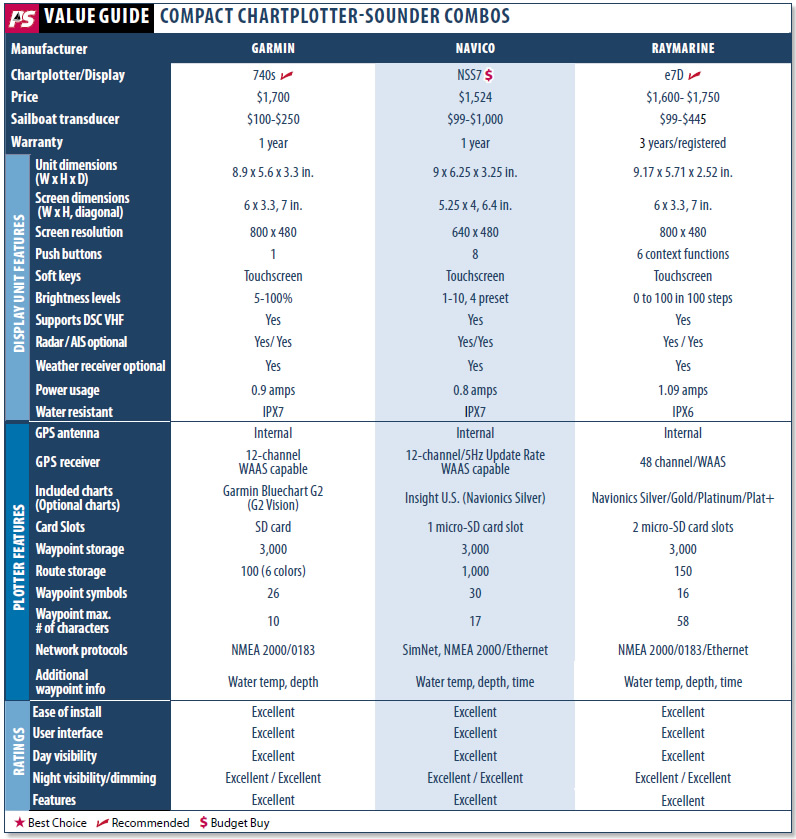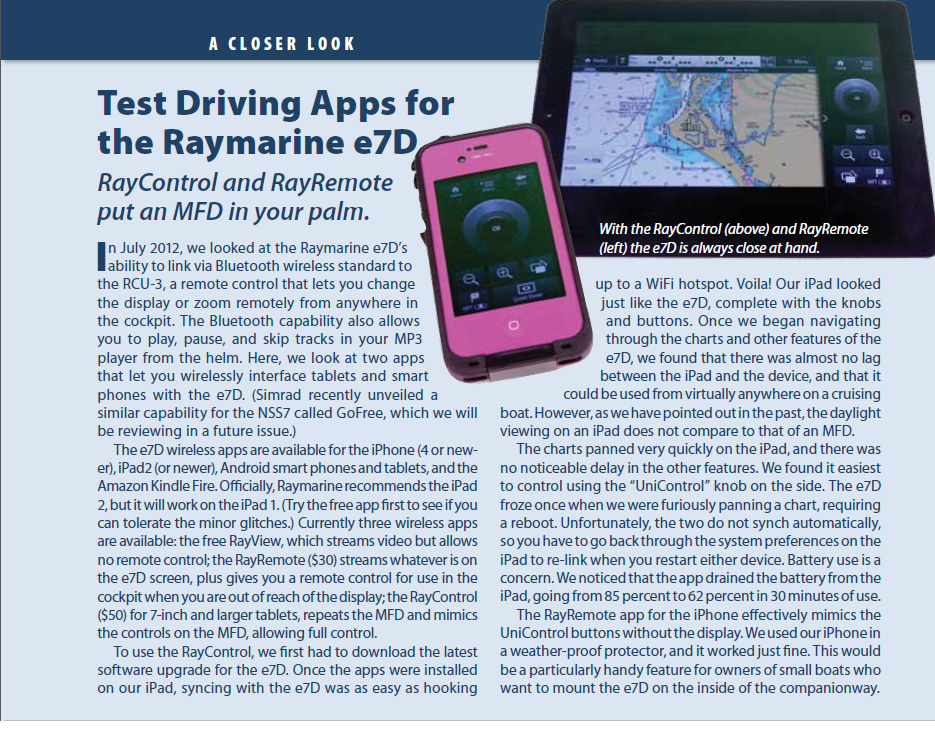Since testing the Garmin 740s (PS, November 2011) and more recently, the new hybrid-touchscreen Raymarine e7D (July 2012), Practical Sailor has had the opportunity to take a long-term look at the equivalent unit from Navico, the Simrad NSS7.
Although the National Marine Electronic Association introduced the NMEA 2000 standard to simplify mixing and matching of units from different manufacturers, this approach works better in theory than it does in practice. Even today, there is considerable merit in building a network from one supplier, offering trouble-free plug and play with current models. (This doesn’t always apply to older gear, but thats a gripe for another day.) Sticking with one brand has the added bonus of one-stop shopping for customer support and less opportunity for one manufacturer to blame the others gear.

Photos by Jonathan Neeves
What We Tested
For this comparison, we focused on the sounder and chartplotter functions of the Simrad NSS7 multifunction display (MFD). Simrad, B&G, and Lowrance all fall under the Navico family, each aimed at a particular boating niche.
When talking about MFDs, it is important to keep in mind that the MFD is just one component within an expandable network. The Simrad NSS7, like the Raymarine e7D, can be integrated into complex networks with more than one multi-function display, multiple sensors, and layers of redundancies. The Garmin 740s, on the other hand, integrates the essentials a cruiser might need-from radar to satellite weather to AIS, but can’t be networked into other MFDs.
No matter which MFD you like, you also need to think about what other electronics you plan to include in your network. For example, if you are dead set on Simrads new 4G Broadband radar (which we will be reporting on next month), then you might lean toward Simrad, but if you already have a suite of Raymarine instruments, the e7D would be a logical choice. As we mentioned, you can mix and match-plenty of sailors do-but staying with a single maker simplifies the process.
For this onboard trial, PS installed the NSS7 with other compatible Simrad units, including a fluxgate compass, depth sounder, and 3G Broadband radar. Introduced in 2012, the NSS7 could be considered a hybrid touchscreen, meaning that, like the Raymarine e7D, you can operate it using buttons, or by using the touchscreen interface. Simrad calls the interface Touch Sensible. The advantages of this interface over a pure touchscreen MFD like the Garmin 740s is that the buttons are generally easier to use in rough conditions, and they will work with gloves; touchscreens wont.
How We Tested
Although our test of the NSS7 was a longer-term field evaluation, it focused on the same four elements as our recent tests of the Garmin 740s and the Raymarine e7D.
- Installation: Testers followed the makers instruction for installation and evaluated directions for interfacing with peripheral devices. They made two mock calls to customer support at lunch hour on a weekday, asked identical questions, and rated the responses.
- Screen visibility: Three testers subjectively rated screen visibility in bright sunlight (with and without polarized sunglasses), at night, and in the shade. The screen was viewed from different angles. Dimming ability and palettes also were compared.
- Environmental tests: Testers evaluated the units resistance to heavy splashing and rain to IPX6 standards, which require that a device withstands water sprayed through a 12-millimeter nozzle at a rate of 100 liters/minute for at least three minutes.
- Plotter: Testers evaluated key functions, including adding waypoints, building routes, and activating man-overboard functions or aids.
- Sounders: Each sounder was rated for presentation and ease of use while following a test track and doing spot soundings over known structure. Speed during testing was approximately 6 knots, and depths varied from 6 to 60 feet. PS installed the NSS7 on a 38-foot sailing catamaran on a swivel arm that allowed the unit to be used in the saloon and at the helm station. The unit was not interfaced with an autopilot, although that is, of course, an option.
Since this was a longer-term field test, we kept a close watch for the most common complaints we get from readers regarding plotter-sounders: fogging screens, water intrusion, poor visibility in bright sunlight, and slow redraw rates. None of the test products experienced serious problems during our environmental testing.
Installation
In the past decade or so, Simrad has done a remarkable job addressing what was once a chief complaint with its products. While highly prized by professional mariners for their reliability and performance, some recreational sailors found Simrads plotters and radar complicated to use. The manuals were classic examples of lost in translation. Not so anymore.
The pre-cut wiring loom for our networked system was easy to install, thanks to proprietary, color-coded wires with terminal plugs at both ends (except for the depth transducer). Using pre-made wires means you have to carefully measure the cable runs before ordering, and leave some margin for error.
It was frustrating to have to supply three separate power feeds-one to the NSS, one to the 3G radar interface box and one to the Ethernet switch/expansion port. Installers also wrestled with what PS tester Bill Bishop calls Big Connector Syndrome, which required oversized holes to accommodate the fat plugs, as big as 1 inches in diameter, four times the diameter of the wire itself.
Once the cables were all connected, the NSS7 fired right up, and it all worked perfectly, straight out of the box, something that weve come to expect with todays electronics. Like the other high-end similar MFDs in this test, the Simrad NSS7 uses a magnetic catch for its micro SD card. The obvious location of this waterproof unit is at the helm, but because the magnet and other components can create their own powerful magnetic field, the maker advises keeping it at least 39 inches from a magnetic compass.
The NSS7 will network with a stunning range of Navico products and NMEA 2000 inputs, including Simrad wind instruments, AIS, audio (Navicos SonicHub), StructureScan (side-scan sonar), engine data, Sirius satellite weather, autopilot, HD Radar (up to 25kW), and other Simrad MFDs. The network is compatible with both NMEA 0183 and NMEA 2000, as well as its own SimNet system.

Once testers had the NSS7 up and running, they werent happy with the alarm, and this seems to be a common feature on all the MFDs we test these days. Fortunately, theres a simple solution: a loud piezoelectric alarm bought at a local electronics supplier for less than $10. Simrad even conveniently includes wiring instructions for an alarm in its installation manual. The piezo electric alarm can increase heart rate, but at least you wont sleep through it.
The NSS7 is the smallest in the NSS line, which also includes the NSS8 (8-inch diagonal screen) and NSS12 (12-inch diagonal screen). The NSS7 uses both a tactile rotary knob, eight push-buttons, touchscreen, and a drag capability. While the number 7 suggests a seven-inch diagonal screen, the NSS7 actually has a 6.4-inch diagonal screen, slightly smaller than the screens of the Garmin 740s and Raymarine e7D. The overall dimensions of the NSS7 are also slightly smaller. There is also a nominal drop in power use.
The NSS7 has a built-in echo-sounder and internal GPS. There is an optional external GPS, but ours worked fine without it. The NSS7 comes pre-loaded with U.S. coastal and fishing charts, but it is possible to upgrade charts to Navionics Platinum , at a price. Chart updates, extensions, or software updates are made through the single microSD card slot. The microSD can also be used to download waypoints, routes, and screen shots.

Interface
PS testers found the unit to be fairly intuitive after getting used to it. For anyone who has spent some time with a smart phone or iPad, its screen-selection interface and menu navigation will be second nature. Testers did notice some inconsistency in the interface. For example, when navigating the menu, sometimes you would use the touch screen to access submenus, but in other cases, you had to select by touching the center of the rotary knob.
Changing chart scale was logically done with the rotary knob or by using the dedicated or – keys. The rotary knob wont change the chart scale, however, while you are in radar overlay mode and the display is set for full-screen radar. You easily get used to these idiosyncrasies, so it is not a big drawback.
The owners manual was excellent and featured easy-to-understand illustrations. A searchable PDF of the users manual is stored within the file structure, so it is always with the unit. Testers found fault only in the instructions for software updates, which did not indicate the need for a reboot after updating.
The standard screens show the usual data: speed over ground (SOG), course over ground (COG), latitude and longitude, depth, and local time. Symbols also indicate the status of the sounder, alarms, and radar. In chart mode, setting waypoints, and routes was simple, the man-overboard (MOB) function was easy to use, even for a novice. Accessing and modifying the waypoint and chart files is easy, but we did need to check with the manual to learn how to find the files. This was one of the few operations demanding use of the center button of the rotary knob. Downloading the files to the micro SD card, to save to a computer, was very simple.
Radar
PS used Simrads 3G Broadband radar with the NSS7, and a full review and comparison of the 3G and 4G broadband radars will appear next month. Radar is either, off, at stand-by, or on. Switching from stand-by to on is instantaneous. The radar offers 17 different scales from 5 nautical miles to 24 nautical miles, with or without range rings.
In overlay mode, the radar range automatically switches to one of the default ranges that is closest to the active chart range. In full screen radar, you set the range using the or – keys. It was possible to access ranges greater than 24 nautical miles by relocating the screen center, but target returns beyond 20 nautical miles were inconsistent.
Radar can be displayed as chart overlay, as a single full-screen, or split screens in combination with either the sounder or charts. (The NSS8 and NSS12 can display two-, three-, or four-way split.) Radar overlayed on a chart could then be used as a split screen with the sounder, radar alone, or chart alone. Testers found the best default setting with active radar was a full screen with radar overlay. For better radar detail, you can switch to full-screen, radar-only mode to confirm any targets that might get lost in the chart detail.
A screen this small can start to get very cluttered if you try to superimpose AIS, radar, and chart (along with a route and waypoints) data, so if you envision using all these functions at once, you might consider moving up to a larger screen.
The newer, 4G radar can use two scales simultaneously, using split screens, but this is not currently supported by the NSS units. However, beam sharpening, improved 4G target separation, and better target separation at close range is automatic for 4G with the NSS7.

Manual adjustments were all easy to carry out. Users can choose between three views-north up, heading up, or course up-and the radar center can be moved, offering the option to look further ahead or to one side, a handy feature for a small display.
Measuring bearing and distance to a target was simple: Just tap the screen to bring up the cursor. The same technique is used for charts, although we found it difficult to precisely place waypoints if you have big fingers, or are working in a rough sea. Radar guard zones are also easy to establish. Close range target identification was so clear and stunning you could take your yacht into a marina based only on the radar image.
Depth sounder
We used the NSS7 with the basic Airmar P319 transducer. This transducer uses NSSs internal software to capture seabed, fish, and water temperature data. The NSS also supports a number of standard Airmar transducers, including those for sophisticated external echo-sounders such as Simrads Structure Scan (LSS) and broadband sounder module (BSM). Depth and temperature (useful for marking currents) are displayed, and we checked accuracy with a lead line and known chart data.
The echo sounder offers a split-screen function. You can zoom into a specific depth of water, at a magnification of up to eight times. You can also lock into and zoom on the seabed. Options for sounder sensitivity (including auto), echo frequency, and external noise rejection are all available.
We could not find a way to switch the echo-sounder off, so if you are crossing the Pacific and want to cut back on power usage when you are off soundings, unplugging the unit seems to be the only option.
Conclusion
Can we recommend the NSS? Absolutely. Its intuitive touchscreen interface is equal to or better than that on the Raymarine e7D, and the optional manual controls puts its interface a step above the Garmin 740s, in our view. The price is also competitive, although the costs for cable (not included) can add up fast. Raymarines free extended three-year warranty is stronger.
If you like Navicos product lineup and want a compact and easy-to-use MFD, then go for the NSS7. It will do everything you want and more, and it will do it simply.
If you already have a suite of Raymarine gear onboard and like a bigger screen, then the Raymarine e7D or its kin is your ticket. Also, the e7Ds UniControl still leads the pack for button control. Right now, the e7D also has the wireless edge (see adjacent article on Raymarine apps), but Simrads recently released GoFree apps apparently closes that gap.
Finally, for loyal fans of Garmin who have no plans to network with other onboard MFDs and are just looking for a stand-alone network that delivers all the essentials in one unit, the Garmin 740s interface is still a benchmark for ease of use. Its touchscreen-only system is tops for watertightness.
Finally, if you are starting from scratch, look at the NSS7 and Raymarine e7D, although we are still comparing components within each network (starting with radar next month).
The good thing with either of these systems is that you have a flexible platform for add-ons and upgrades. The bad thing is that you may almost come to believe that all of these functions can actually be effectively put into action on a tiny screen, when in fact they can’t. A 7-inch screen is a terrific navigational tool for the cockpit, but the user needs to be ever mindful of the risks that come with using digital charts, particularly on displays of this size.


































